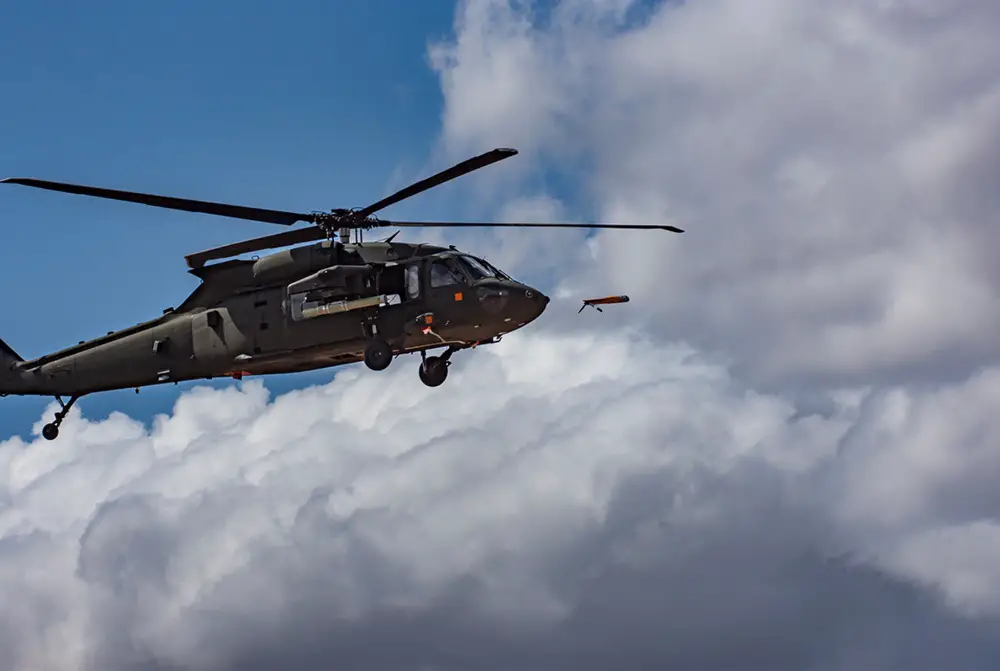Dozens of sets of eyes looked skyward at Yuma Proving Ground, Arizona, in early March to watch the forward launch of an unmanned aircraft system from a helicopter and from a moving vehicle on the ground.
“This may seem like just another event – like ‘well, we’ve done another experiment, we’ve done another demonstration’ – but this is the capstone,” said Col. Matthew Isaacson, Future Vertical Lift Cross Functional Team chief of operations.
The U.S. Army Combat Capabilities Development Command Aviation & Missile Center Technology Development Directorate led the demonstration that highlighted the forward air launch of Area-I Air-Launched, Tube-Integrated, Unmanned System, or ALTIUS, 600. The demo was the culmination of over a year of buildup, planning and testing and is in line with the Army’s pursuit of leap-ahead technological advances aimed at dominating its adversaries and reaching its Multi-Domain Operations goal.
“We’ve shown that we can be tactically relevant today in a way that redefines what manned and unmanned aircraft do,” Isaacson posited. “So from this point on this day, launching at a tactically relevant altitude, future tactics, techniques and procedures, future enabling technologies, future payloads will stem from this moment.”
“The thing that makes it unique… first of its kind is the fact that it’s done at a tactical altitude in forward flight, which means that as the air-launched effect – that air vehicle – comes out of the tube in forward flight, the rotor system is producing downwash to keep the helicopter aloft and to move it forward … and the ALE must fly through that,” explained Carvil E.T. Chalk, CCDC AvMC TDD deputy director for aviation technology.
It’s even more remarkable due to all the factors that must be accounted for during programming. “When to deploy the wings, when to start the propulsion system on that air launch effect vehicle – getting all of that right, that’s the tricky part,” Chalk said.
With the ultimate goal of gathering intelligence in real time, ALTIUS can be manually flown with a handheld remote or programmed by a ground control station where it can be commanded to navigate to a certain point. Designed to be recoverable, ALTIUS – an orange tubular object with wings that unfold once it self-stabilizes after being launched – can be set to land on any relatively level surface.
“These unmanned aircraft can fly low, they can fly high and they’re small enough to be survivable and they are attritable enough to not need to be rescued,” Isaacson said.

“To date, we’ve only launched from high altitudes which are not survivable in the current battle space,” said Nate Bordick, AvMC TDD-Aviation intelligent teaming lead.
These launches provide tactical effects at strategic and operational distances. Isaacson said operating at high altitudes in a counterinsurgency environment can be survivable, but lower altitude is essential in the peer/near-peer environment. “The lower tier of air domain is decisive. By operating in the lower tier of the air domain, with manned and unmanned aircraft and not having to climb to altitudes where survivability would be a concern, that’s really what AvMC has shown here.”
Reduced vulnerability, increased reach, endurance and standoff are key components of this recently developed technology. Isaacson said standoff of a weapon system or situational awareness on the battlefield is provided by the technology demonstrated at Yuma.
The ALTIUS provides the ability to locate the enemy and relay information that will ultimately be used to protect the Warfighter. “This is an ALE unmanned system with advanced teaming capabilities that are operationally relevant in multidomain operations,” Bordick said. “Over the next couple years we’re going to demonstrate a lot more autonomy, a lot more collaboration from manned/unmanned systems, a teams of teams approach.”
“The opportunity to continue to push the bounds of technological capabilities in support of air-launched effects has proven to be very rewarding,” said Dr. Juanita M. Christensen, AvMC executive director. “These future capabilities will enable our aviators to exhibit a warfighting edge during threat engagements while aiding the survivability of the crew.”
The CCDC Aviation & Missile Center, formerly known as the Aviation & Missile Research, Development and Engineering Center (AMRDEC), is part of the U.S. Army Combat Capabilities Development Command, which conducts responsive research, development and life cycle engineering to deliver the aviation and missile capabilities the Army depends on to ensure victory on the battlefield today and tomorrow. Through collaboration across the command’s core technical competencies, CCDC leads in the discovery, development and delivery of the technology-based capabilities required to make Soldiers more lethal to win our nation’s wars and come home safely. CCDC is a major subordinate command of the U.S. Army Futures Command.
















